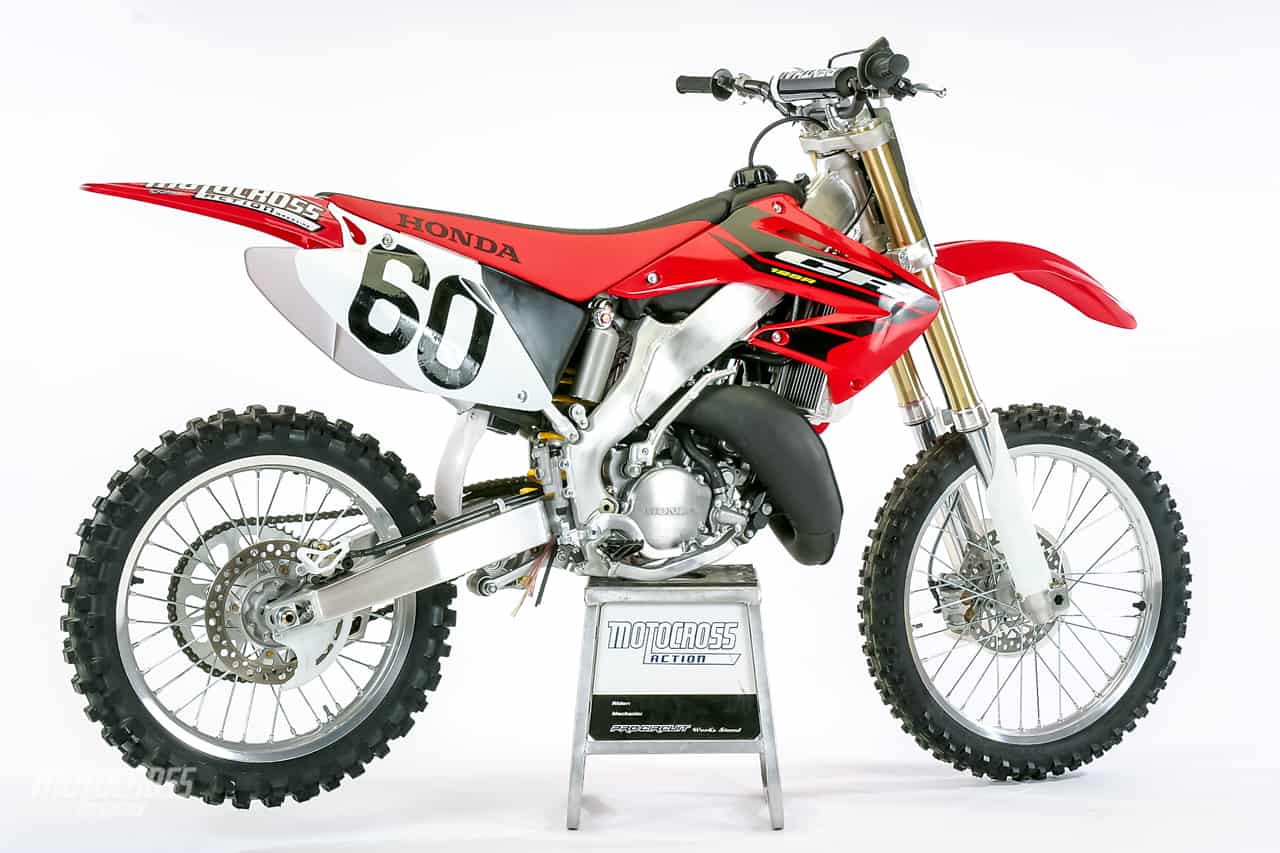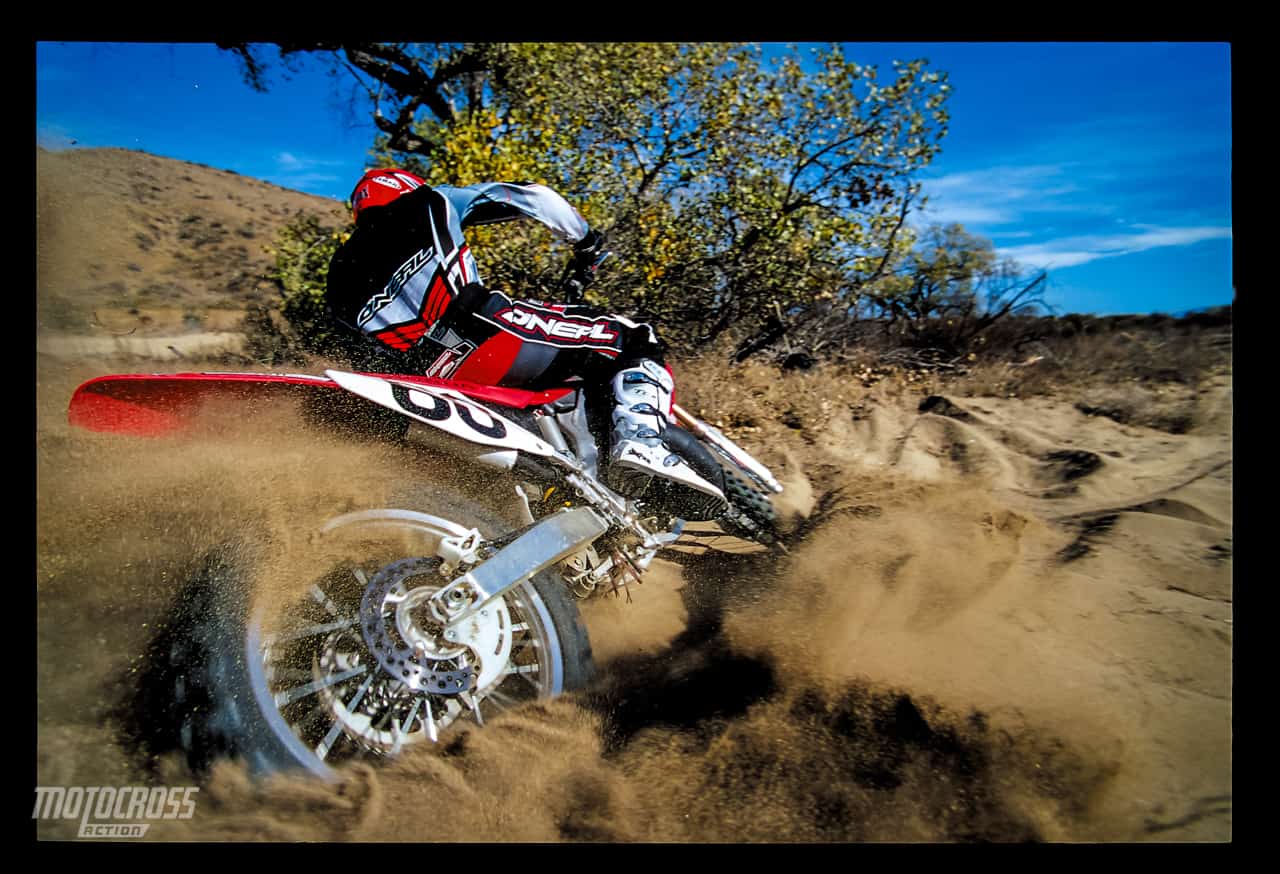TWO-STROKE TUESDAY: WE TEST THE SLOW BUT STEADY 2004 HONDA CR125
 This bike test is from the March 2004 issue of MXA
This bike test is from the March 2004 issue of MXA
For a couple of months it looked like Honda would let the CR125 fall by the wayside–in favor of the CRF250 four-stroke. The day of its 2004 debut came and went with no CR125 insight. Rumor had it that Honda had pulled the plug. Not so! In the end, Honda had simply juggled their production line priorities, pushing the 2004 CR125’s release date back. Although two-stroke conspiracy theorists were quick to point out the CRF250 hadn’t been pushed back. In fact, according to Honda sources, the CR125’s original production line time was used to make more CRFs.
You can’t blame anyone, consumer or Honda, for predicting the CR125’s demise. After all, the 2003 CRF450 took a major bite out of 2003 CR250 sales, and it doesn’t take the Amazing Kreskin to imagine what the mid-sized CRF will do the troubled CR125’s sales figures.
 The 2004 Honda CR125 was a blast to ride , but when the powerful CRF250 was released potential CR125 buyers were caught between a rock and hard place. Most jumped ship to the four-stroke.
The 2004 Honda CR125 was a blast to ride , but when the powerful CRF250 was released potential CR125 buyers were caught between a rock and hard place. Most jumped ship to the four-stroke.
But Honda surprised us with a completely new 2004 engine (okay, maybe not completely new) that features more technical advances than any bike in the 125 class. This had us wondering, is the CR125 really on its death bed or just lying low? The answer would present itself rather quickly.
Q: IS THE 2004 CR125 FASTER THAN THE 2003?
A: Yes. But these are baby step improvements. Honda is going in the right direction with its 125 two-stroke, but they have a long way to go to get up to contemporary standards.
Q: WHAT’S NEW ABOUT THE 2004 ENGINE?
A: Honda debuted the first-ever electronically controlled power valve on the CR250 several years ago, and, for 2004, the CR125 gets the same amalgamation of computer chips, sensors, servos and cables. Installing the electric power valve required Honda to cast a completely new cylinder. So, while they were refurbishing the top-end, Honda’s engineers added a domed piston and new combustion chamber. Additionally, every port went through rehab, as well as the reed valve, pipe and silencer.
 Every MXA test rider loved the handling, suspension, ergos, front brake, Dunlop tires, Renthal bars and light feel of the CR125, but the CR125 engine in comparison to the KTM 125SX was four horsepower off. At 10,500 rpm there was more than a seven horsepower deficit.
Every MXA test rider loved the handling, suspension, ergos, front brake, Dunlop tires, Renthal bars and light feel of the CR125, but the CR125 engine in comparison to the KTM 125SX was four horsepower off. At 10,500 rpm there was more than a seven horsepower deficit.
Q: DID THIS EXTREME MAKEOVER FIX THE CR125’S POWERBAND WOES?
A: No. As cutting edge as the aluminum-framed, electronic power-valved 2004 CR125 is, all the technology in the world won’t help if the bike is slow.
Q: HOW MUCH POWER DOES THE CR125 MAKE ON THE DYNO?
A: How much power doesn’t it make on the dyno would be a better question. The 2004 CR125 makes 30.6 peak horsepower at 11,000 rpm. For comparison purposes, the 2004 KTM 125SX makes 34.5 horsepower at 10,500 rpm. That’s a four horsepower deficit at peak. But, that doesn’t even tell half the story. If you go back to 10,500 rpm, where the KTM is making 34.5 horsepower, the CR125 is only making 27 horsepower. That’s close to eight horsepower less. And we are only using the KTM as an example. The CR125 doesn’t beat the RM125, YZ125 or KX125 at any point on the dyno curve either.
Q: WHAT IS THE CR125 LIKE ON A RACE TRACK?
A: Better than on the dyno. Instead of feeling the deficiencies in horsepower, you feel the lack of torque as the CR125 has trouble generating thrust out of corners. The CR125’s max torque is 14.9 lb-ft. On the opposite end of the spectrum, the KTM 125SX’s max torque is 17 lb-ft.
Q: CAN’T GEARING HELP IT GET OUT OF CORNERS?
A: It could, but Honda’s engineers beat you to the punch. The 2004 CR125 comes with a 53-tooth rear sprocket. As a matter of practically, 54-tooth rear sprockets are hard to find on dealers’ shelves. We switched to a 12-tooth countershaft sprocket and a 49-tooth rear sprocket to get more propulsion.
Q: HOW GOOD IS THE CR125 SUSPENSION?
A: We can’t say enough good things about the CR125’s suspension. Back in the day, Honda CR125’s were best known for their incredible engines and so-so suspension. In a reversal of fortune, the 2004 CR125 has amazing suspension and a so-so engine.
Forks: With 0.44 kg fork springs installed at the factory, you might think that the CR125’s forks would be stiff, but in truth, they are just about perfect. The 46mm Kayaba forks soak up the little stuff, absorb the medium stuff and handle the big stuff.
Shock: Unlike the forks, which have a fairly stout spring rate, the shock uses a relatively conventional 4.7 kg/mm spring. Conventional wisdom would suggest that the stiff fork springs and soft shock spring would make the suspension totally out of balance, but that’s not the case. To get the most out of the suspension on your CR125, set the sag at 100mm, the clickers on the book settings and leave it alone. It’s that good.
 The CR125 powerplant is no powerhouse on the dyno. But on the dirt dyno the gap did not feel as big to its competition.
The CR125 powerplant is no powerhouse on the dyno. But on the dirt dyno the gap did not feel as big to its competition.
Q: WHAT DID WE HATE?
A: The hate list:
(1) The grips: Honda use to have great grips. Now, they are unyielding and have a propensity to shred hands.
(2) Engine: It’s a crying shame that Honda spent a tremendous amount of money on new engine castings in 2004 to no avail. It has been proven over and over again that band-aiding an old design rarely achieves the desired results. Honda should have bit the bullet five years ago and started with a blank sheet of paper.
(3) Rear brake: Brake draggers will get the rear brake to overheat. If this isn’t you, don’t worry.
(4) Airbox: It’s best to talk a friend into cleaning your air filter.
Q: WHAT DID WE LIKE?
A: The like list:
(1) Suspension: The CR125 suspension is simply amazing. It works for all levels of riders.
(2) Reliability: The CR125 will last two seasons without breaking a sweat.
(3) Handlebars: What’s not to like about aluminum Renthals?
(4) Components: Now that Honda has thrown a really good clutch perch and a set of aluminum handlebars on the CR125, it’s hard to complain about any of the components. They are all topnotch.
(5) Ergonomics: The handlebar bend is perfect. The footpegs are in the right position (unlike on the CR250). The seat is a gripper (and seems firmer than last year), and all the bolts are properly sized and spec’ed.
Q: WHAT DO WE REALLY THINK?
A: This bike is a blast to ride. Every MXA test rider loved the handling, suspension, ergos, front brake, Dunlop tires, Renthal bars and light feel. But, and there is always a but when something is this good, it’s not fast enough. Not by a long shot.







Comments are closed.